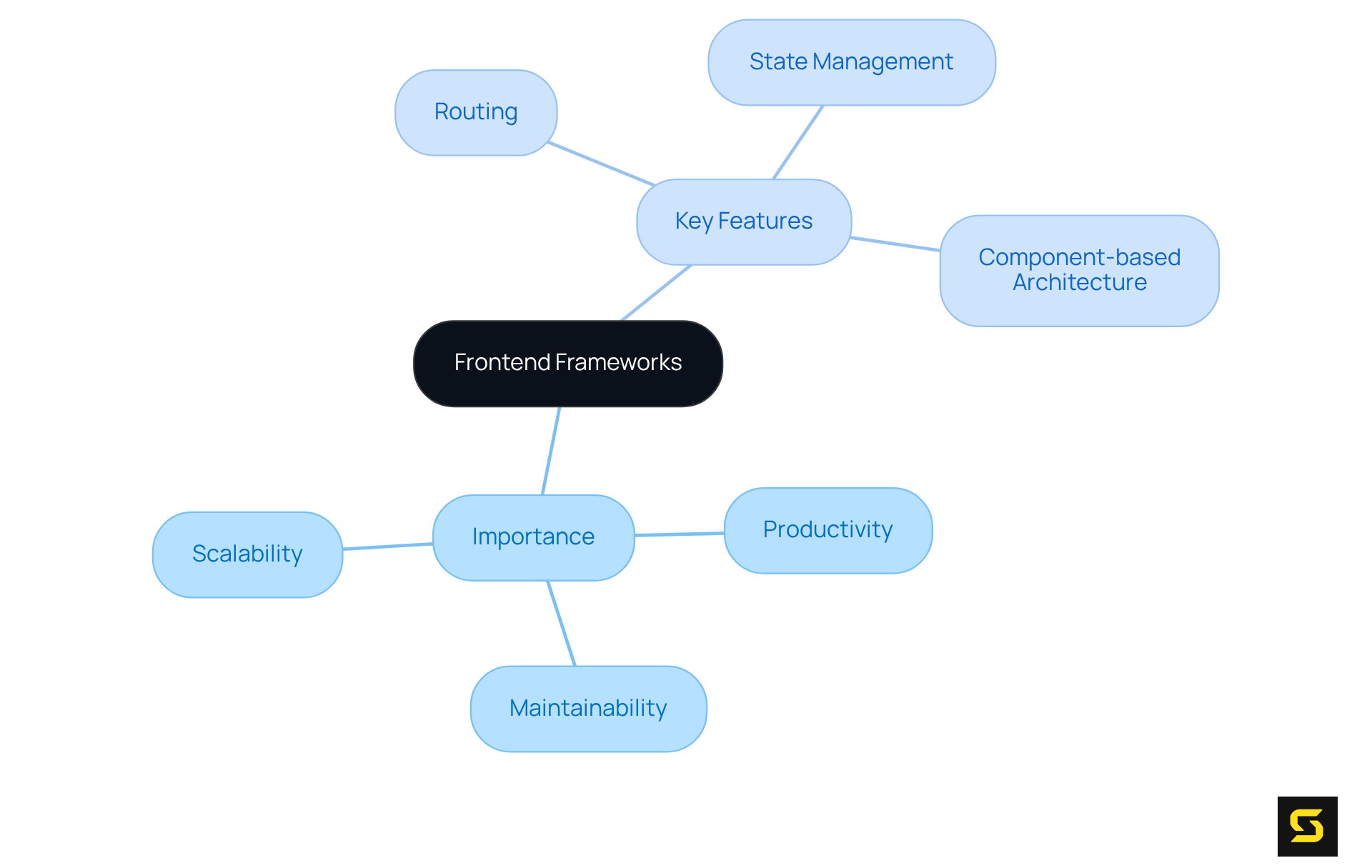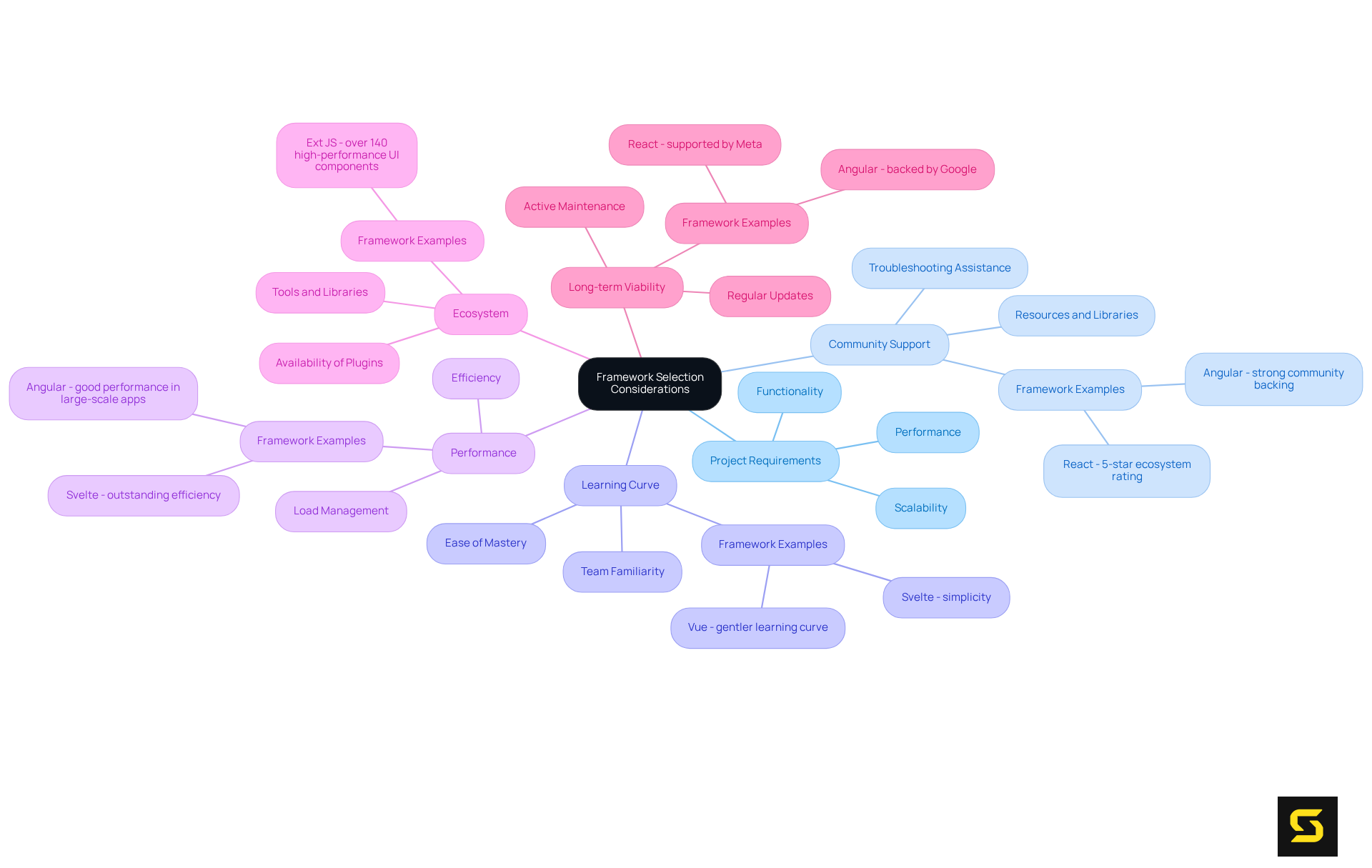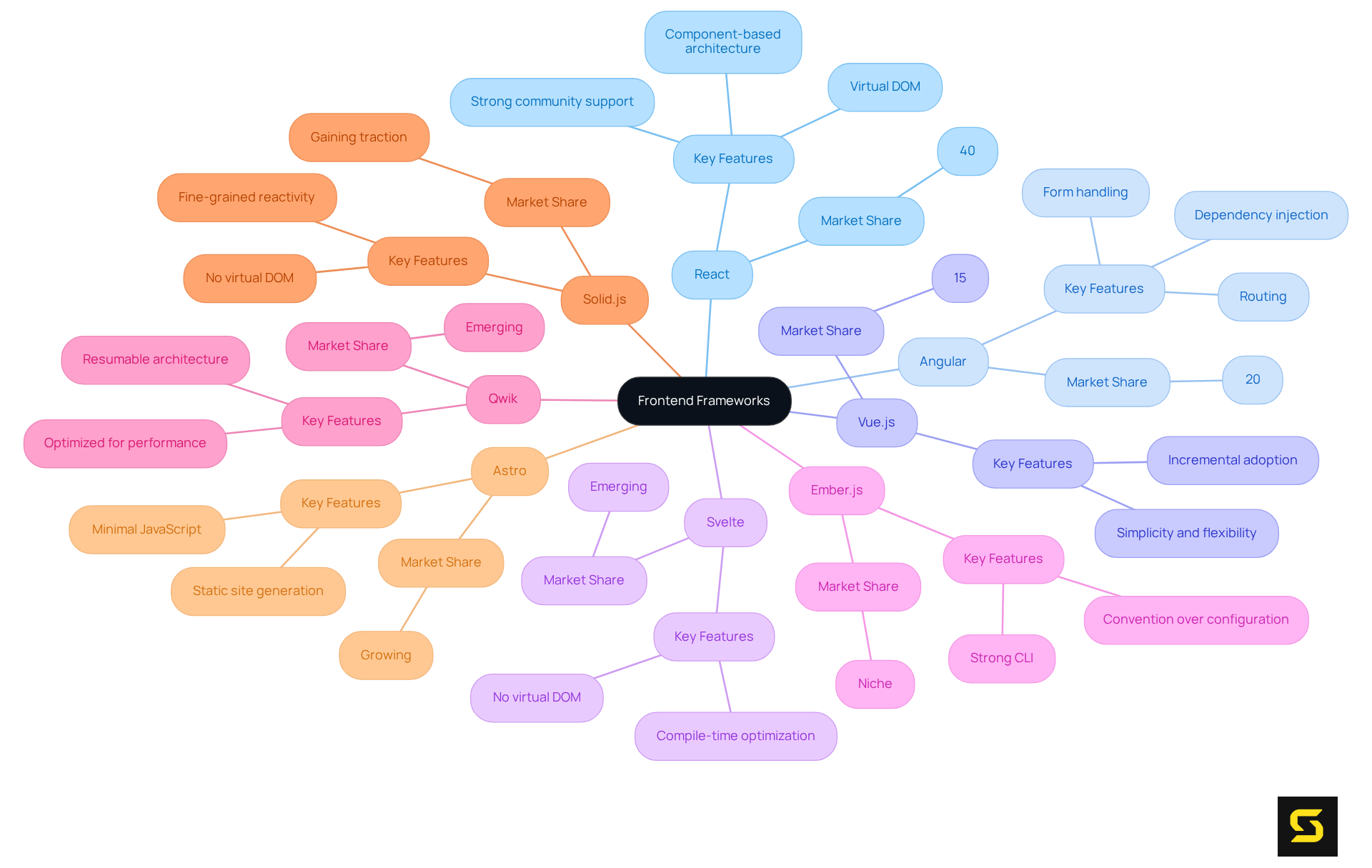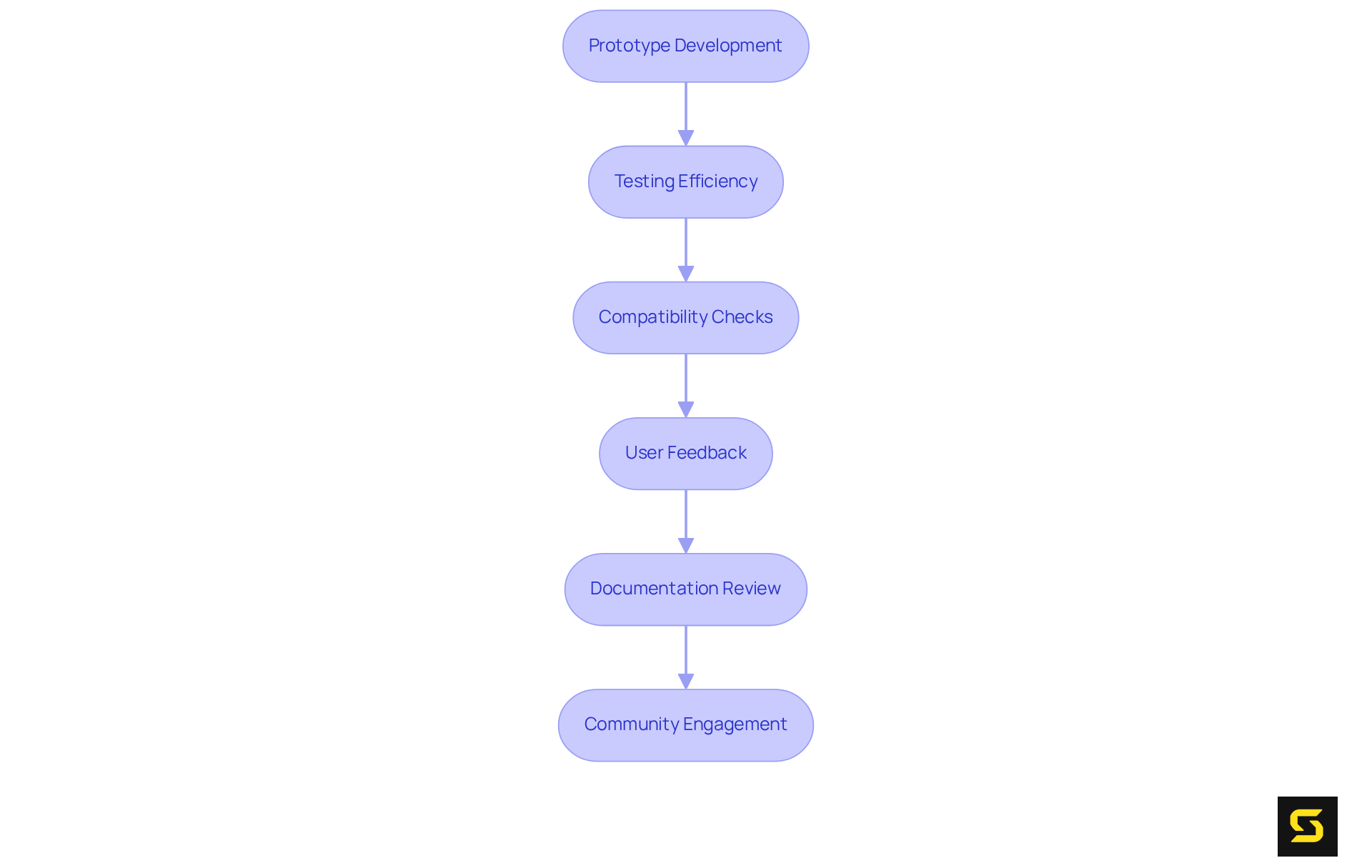Overview
Frontend development frameworks serve as crucial tools that significantly enhance productivity, maintainability, and scalability in web application development. They provide structured environments that streamline coding processes, making them indispensable. This article outlines essential considerations for selecting a framework, delves into popular options such as:
- React
- Angular
- Vue.js
It emphasizes the necessity of evaluating frameworks based on:
- Project requirements
- Community support
- Long-term viability
Such evaluations are vital to ensure optimal development outcomes.
Introduction
Frontend development frameworks have fundamentally transformed the way developers craft user interfaces, empowering them to construct dynamic and responsive web applications with remarkable efficiency. This article examines the critical elements of mastering these frameworks, from grasping their importance to assessing the most prevalent options available today.
However, with a plethora of frameworks at one's disposal, how can one ascertain the best fit for specific project requirements? Delving into this inquiry will illuminate the essential considerations that facilitate informed decision-making in the continually evolving realm of web development.
Define Frontend Frameworks and Their Importance
Frontend systems represent a pivotal advancement in the development of user interfaces for web applications. The frontend development framework provides structured frameworks that streamline the software creation process, allowing developers to focus on functionality rather than repetitive coding tasks. The true value of these systems lies in their ability to , maintainability, and scalability of web applications. By leveraging a well-defined structure, developers can utilize essential built-in features such as:
- Routing
- State management
- Component-based architecture
This not only expedites development time but also significantly elevates code quality. Prominent frontend development frameworks like React, Angular, and Vue.js exemplify how these tools facilitate the creation of dynamic and responsive web applications. Embrace the power of frontend systems to transform your development process and achieve superior results.

Identify Key Considerations for Framework Selection
When selecting a frontend framework, several key considerations must be meticulously evaluated:
- Project Requirements: Begin by thoroughly assessing the specific needs of your project, including functionality, performance, and scalability. Understanding these requirements is essential for ensuring alignment with your business objectives.
- Community Support: A vibrant community can significantly enhance your development experience by providing invaluable resources, libraries, and troubleshooting assistance. Frontend development frameworks like React and Angular thrive on extensive community engagement, facilitating quicker problem resolution and access to a vast array of third-party libraries. For instance, React boasts a 5-star ecosystem rating, underscoring its strong community backing.
- Learning Curve: Evaluate the ease of mastering the framework, particularly if your team is unfamiliar with it. Frontend development frameworks with a gentler learning curve, such as Vue, can expedite onboarding and minimize training time, making them ideal for teams eager to implement solutions swiftly.
- Performance: Scrutinize how effectively the framework performs under load and its capability to manage intricate systems. Notably, Svelte is recognized as a frontend development framework for its outstanding efficiency, attributed to its compilation approach, making it suitable for data-intensive applications. In comparative analyses, Svelte has consistently been noted for its superior performance due to the absence of a virtual DOM.
- Ecosystem: Investigate the availability of plugins, tools, and libraries that can enhance efficiency and capabilities. A robust ecosystem can streamline development processes and provide ready-made solutions for common challenges. For example, Ext JS offers over 140 high-performance UI components, which can significantly bolster your development efforts.
- Long-term Viability: Ensure the framework is actively maintained and regularly updated to prevent future compatibility issues. Frontend development frameworks supported by major corporations, such as Angular (Google) and React (Meta), typically offer superior long-term support and stability, which is crucial for enterprise-level applications.
By carefully evaluating these critical elements, you can make a well-informed decision that aligns with your project's requirements and propels your progress forward.

Explore Popular Frontend Frameworks and Their Features
The landscape of frontend development is dominated by several key frameworks, each offering unique features tailored to different project needs:
- React: Developed by Facebook, React is a component-based library renowned for its efficiency in building dynamic user interfaces. Its virtual DOM enhances performance, rendering it especially suitable for systems that demand frequent updates and interactivity. With a significant of around 40%, React is a preferred choice among developers.
- Angular: As a comprehensive framework maintained by Google, Angular provides a robust solution with built-in functionalities such as dependency injection, routing, and form handling. This renders it an outstanding option for large-scale uses that require a structured and scalable approach. As a frontend development framework, Angular currently holds approximately 20% of the market share, reflecting its suitability for enterprise-grade solutions.
- Vue.js: Celebrated for its simplicity and flexibility, Vue.js allows developers to adopt its features incrementally. It efficiently merges the advantages of both React and Angular, rendering it a flexible choice for projects of different scales, from small programs to intricate systems. With a market share of about 15%, Vue.js appeals to a wide range of developers as a leading frontend development framework.
- Svelte: A modern framework that stands out by shifting much of the workload to compile time, Svelte enhances runtime performance by compiling components into optimized JavaScript during the build process. This innovative method serves as a frontend development framework that leads to quicker software with minimal overhead, making it increasingly favored by developers.
- Ember.js: Ember is designed for ambitious web projects, emphasizing a convention-over-configuration philosophy. Its organized structure is perfect for developers looking for a thorough solution that supports the creation of intricate applications with a clear set of guidelines.
- Qwik: An emerging framework known for its novel resumable architecture, Qwik is optimized for efficiency and scalability, making it suitable for modern web development needs. Its unique approach allows for instant interactivity by resuming execution from the server, drastically reducing load times.
- Solid.js: Gaining traction for its performance and innovative reactivity model, Solid.js allows for efficient DOM operations without the overhead of a virtual DOM. This makes it a strong alternative for high-performance applications.
- Astro: Optimized for static site generation, Astro is gaining popularity for its ability to deliver fast page load times and minimal JavaScript shipped to the browser, making it an excellent choice for content-heavy websites.
As we look towards 2025, the evolution of frontend development frameworks continues, providing developers with a variety of choices to effectively address diverse project needs.

Evaluate and Test Frameworks for Your Project Needs
To effectively evaluate and test frontend frameworks for your project, it is essential to follow these steps:
- Prototype Development: Begin by constructing a small prototype using the framework's structure. This practical approach allows you to assess the ease of use and effectiveness of the frontend development framework in a real-world scenario, providing invaluable insights into its capabilities. Furthermore, consider the long-term maintainability and scalability of the framework, as these aspects are critical for future development.
- Testing Efficiency: Conduct comprehensive tests to measure load times, responsiveness, and resource consumption under varying conditions. This step is vital, as users in 2025 anticipate fast load times and seamless interactions from frontend applications. Including specific performance metrics will aid in evaluating how effectively the system meets these expectations.
- Compatibility Checks: Ensure that the framework integrates seamlessly with existing tools, libraries, and backend systems. Compatibility is crucial for maintaining workflow efficiency and avoiding integration challenges.
- User Feedback: Solicit who will utilize the system. Understanding their experiences and challenges can help pinpoint potential pitfalls and areas for enhancement.
- Documentation Review: Scrutinize the system's documentation for clarity and comprehensiveness. Well-structured documentation significantly eases the learning process and minimizes false starts during development. Look for sample code within the documentation, as this can be particularly beneficial for understanding how to utilize the system effectively.
- Community Engagement: Participate in community forums or discussions to evaluate the level of support and resources available for the framework. A robust community can provide valuable insights into common issues and solutions, enriching your overall development experience. Be aware that popular frameworks may not always boast the most active communities, making it essential to assess community presence.
By adhering to these steps, you can make informed decisions that align with your project's specific needs and ensure a successful implementation.

Conclusion
Frontend development frameworks are instrumental in enhancing the efficiency and quality of web application development. They provide structured methodologies and essential features that empower developers to streamline workflows and focus on delivering high-quality user experiences. By embracing frontend frameworks such as React, Angular, and Vue.js, developers can significantly boost productivity, maintainability, and scalability, ultimately resulting in superior web applications.
Key considerations for selecting the right framework include:
- Project requirements
- Community support
- Learning curves
- Performance
- Ecosystem
- Long-term viability
Each of these factors is critical in ensuring that the chosen framework aligns with specific project goals and facilitates a smooth development process. A closer examination of popular frameworks reveals their unique strengths, catering to a diverse range of project needs and preferences.
In today's rapidly evolving digital landscape, the necessity of making informed decisions regarding frontend frameworks is paramount. By thoroughly evaluating and testing frameworks based on the outlined criteria, developers can confidently select the best tools for their projects. This proactive approach not only enhances the development experience but also lays the groundwork for delivering exceptional web applications that meet user expectations and withstand the test of time.
Frequently Asked Questions
What are frontend frameworks?
Frontend frameworks are structured systems that aid in the development of user interfaces for web applications, allowing developers to focus on functionality rather than repetitive coding tasks.
Why are frontend frameworks important?
They enhance productivity, maintainability, and scalability of web applications by providing a well-defined structure and built-in features.
What built-in features do frontend frameworks typically offer?
Frontend frameworks typically offer features such as routing, state management, and component-based architecture.
How do frontend frameworks affect development time and code quality?
They expedite development time and significantly elevate code quality by streamlining the software creation process.
Can you name some prominent frontend development frameworks?
Some prominent frontend development frameworks include React, Angular, and Vue.js.





